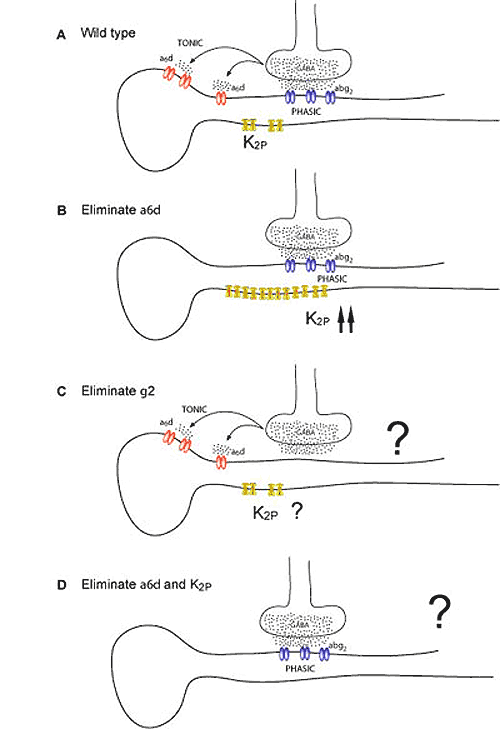Current Research
A novel pharmaco-genetic method for studying neural circuitry
To understand how different neuronal types function in networks and, ultimately, how they influence behaviour, it would be useful if the activity of these neurons could be influenced reversibly [1]. Although genes can be turned on and off cell-type-selectively, these methods applied to the mouse brain are too slow (weeks) to study fast-acting systems. Acute pharmacological intervention is the most promising strategy: drug action should be cell-type-selective, immediate, reversible and stoppable by an antagonist. Our strategy, developed collaboratively with the W. Sieghart (Vienna), M. Farrant (London), E. Korpi (Helsinki), and P. Somogyi (Oxford) groups, exploits GABAA receptor pharmacology to selectively and reversibly attenuate and stimulate neuronal activity. Zolpidem (Zo) and β-carbolines (βCs) enhance and inhibit, respectively, GABAA receptors with a γ2 subunit. We made a mouse line insensitive to these drugs by changing the codon for phenylalanine 77 (F77) to isoleucine (I) in the γ2 subunit gene [4]; and restored Zo and βC-sensitivity to F77I brains by expressing the wild-type γ2 subunit with cell type-specific transgenes (unpublished). These cell types can then be inhibited or activated with Zo or βCs. The method combines pharmacology (fast, reversible drug action) with genetics (specificity). The strategy can be extended to target many types of neurons.
GABAA receptor and two-pore domain potassium (2PK) channel diversity
This project, in collaboration with Dr Mark Farrant and Prof. Stuart Cull-Candy at the Dept of Pharmacology, UCL, London, and Dr Stephen Brickley (Imperial College, London), initially focused on why cerebellar granule cells have a multiplicity of GABAA receptor subtypes, specifically, the role of tonic (extrasynaptic) and phasic (synaptic) inhibition, and then lead us into the biology of potassium leak conductances (TASK1 and –3 channels) [2]. Using mice with Cre recombinase selectively expressed in mouse cerebellar granule cells [3], we aim to dissect the roles of synaptic and extrasynaptic inhibition by specifically deleting synaptic GABA-A receptors; we have also generated TASK1 and TASK3 KO mice. This project has expanded to look at the general biology of TASK channels, as they are found in many brain regions and in organs such as the heart and adrenal glands.
 |
| Inhibition onto granule cells from the GABergic Golgi cell terminals occurs via synaptic αβγ2 GABA(A) receptors (blue, phasic) and extrasynaptic a6δ-containing GABA(A) receptors (red, tonic). Part of the resting membrane potential is determined by tonic potassium conductances (K2P, green). |

